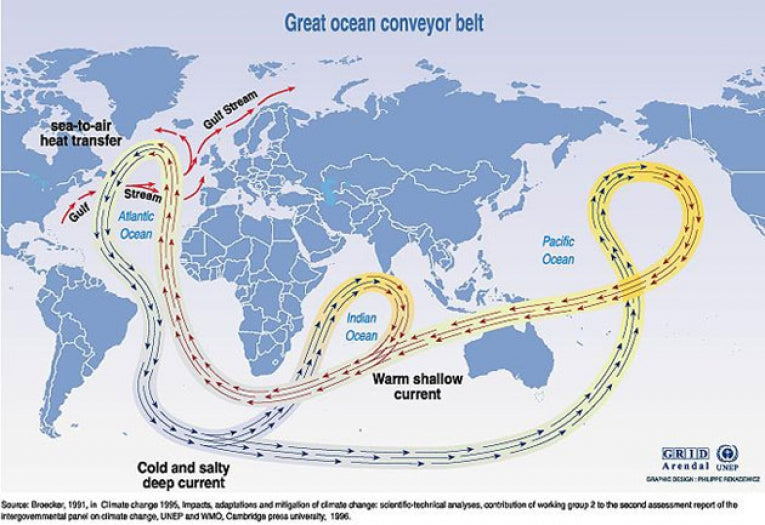Think island, think nature, think ocean, think tranquillity and think pristine. Natural islands have always been escape destinations from the concrete jungle chaos and pollution. Now think again, think unnatural islands, think strewn litter over the ocean, which eventually accumulate as floating marine trash. Who would have thought we could create whole human-made waste catastrophes in the far-off ocean? Plastic discarded in America may be carried for many kilometres over the oceans.
Oceanic Conveyor Belt
Like our atmospheric currents, our oceans function as conveyor belts. The conveyor belt work done by the oceans regulates our climatic control. This role has been diminished by human-induced climate change, this affects human, marine and land life-forms. Adding trash conveyance to the equation, with extensive garbage being recklessly disposed of, we are suffocating the oceans and inhibiting their role on the planet.
Trash Conveyance
The ocean currents move in certain patterns across the globe. Five grand oceans, the Atlantic, Pacific, Indian, Southern and Arctic, they keep the planet cool yet warm enough for our existence and move with strength in an eight-shaped pattern, mixing, blending and moving things along. Atmospheric convection (unequal solar heating causing horizontal and vertical flows) and the earth's rotation are the major forces working on ocean movement producing belts of wind that dominant the planet. Two main wind-forms over the ocean are the trade winds and westerly winds. The friction caused over the ocean surface results in ocean currents.

The Earth's rotation (Coriolis Effect) and the presence of scattered continental landmasses, create a secondary wind-induced surface movement, the Gyre Currents. There are five main Gyres working either westward, eastward, poleward or equatorwards.

Gyres may be seen as the secondary current force but they substantial impacts over coastal temperatures, currents and wind storms. In addition, gyres result in the slow movement of water allowing the trash to collect. The points of convergence are where the deposition of trash occurs and eventually build up to form floating trash islands.
Floating Waste Dumps
An area of concentration for waste over the ocean has been the 'Great Pacific Garbage Patch' located between California and Hawaii. This patch arises from the North Pacific Gyre. There other trash collection zones such as the Sargasso Sea waste hotspot (in the Atlantic Ocean), the Western Pacific Garbage Patch (off Japan's coastline) and the Indian Ocean Garbage Patch (only discovered in 2010).
7 billion throw-away humans
We stand at a growing global population of 7 billion. Not only have we overpopulated, but we have created a global society of waste generators, unnecessary tonnage of fossil-fuel created plastic is demanded in almost every product in our daily life, then we cast them aside instead of reusing and recycling. Landfill sites are out of capacity, land space for toxic dumps destroy wild-lands, vast quantities of domestic garbage are disposed of along rivers, eventually finding their way to the oceans and the obvious direct illegal disposals from sea vessels.
Plastic Flotsam
Captain Charles Moore heading up a team of oceanic researchers discovered that 90% of the floatsam in the Great Pacific Garbage Patch is plastic. Plastic is a generic term referring to a range of human-made petrochemical products. Plastic refers to bottled water containers, caps on sodas drinks, plastic bags, bin-bags, take out containers, etc. Plastics in general take a long time to degrade and therefore are burden, but over land they degrade faster as opposed to in the ocean due to temperature and algal growth on the plastic shielding solar rays. However, plastics never fully degrade, they only become smaller microplastics.
Threats to Marine Life
Plastic and other human generated solid waste are not only pollutants based on their chemical composition but they are physical hazards to wildlife. These hazards become evident when either ingested (choking hazard) or physically debilitating a bird's movement. The consumed pollutant also breaks down releasing toxic PCBs into the sea animal's body. In addition to plastic, fish nets also trap marine life. Marine animals become entangled in the nets and this can lead to injury, starvation and death. Marine life-forms also suffer from life-long disabilities from ocean garbage, namely, plastic bands fitting over baby marine turtles that cause huge physiological deformity as the animal grows (see image below).
If we change our wasteful consumption, unnecessary production of new plastic products, dumping waste, we may save innumerable lives, they may not all be human, but we are responsible for them and all things living on the planet.










